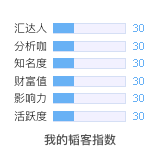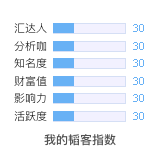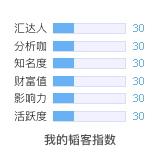[MT4指标]关于Stochastic Oscillator指标详细解释...求转飞狐公式
Name: Stochastic Oscillator, Stochastic
Author: MetaQuotes
Rating: Not rated
Downloaded: 223 times
Download: Stochastic.mq4 (3.8 Kb) View
Description: The Stochastic Oscillator Technical Indicator compares where a security’s price closed relative to its price range over a given time period. The Stochastic Oscillator is displayed as two lines. The main line is called %K. The second line, called %D, is a Moving Average of %K. The %K line is usually displayed as a solid line and the %D line is usually displayed as a dotted line.
There are several ways to interpret a Stochastic Oscillator. Three popular methods include:
Buy when the Oscillator (either %K or %D) falls below a specific level (e.g., 20) and then rises above that level. Sell when the Oscillator rises above a specific level (e.g., 80) and then falls below that level;
Buy when the %K line rises above the %D line and sell when the %K line falls below the %D line;
Look for divergences. For instance: where prices are making a series of new highs and the Stochastic Oscillator is failing to surpass its previous highs.
Calculation
The Stochastic Oscillator has three variables:
%K periods (Pk). This is the number of time periods used in %K calculation. By default is 5;
%K Slowing Periods (Sk). This value controls the internal smoothing of %K. A value of 1 is considered a fast stochastic; a value of 3 is considered a slow stochastic. By default is 3;
%D periods (Pd). This is the number of time periods used when calculating a moving average of %K. By default is 3;
The formula for %K is:
%K = 100*SUM (CLOSE - MIN (LOW, Pk), Sk) / SUM (MAX (HIGH, Pk) - MIN (LOW, Pk)), Sk)
Where:
CLOSE — is today’s closing price;
MIN (LOW, Pk) — is the lowest low in Pk periods;
MAX (HIGH, Pk) — is the highest high in Pk periods.
SUM (CLOSE - MIN (LOW, Pk), Sk) — amount composed CLOSE - MIN (LOW, Pk) for period Sk;
SUM (MAX (HIGH, Pk) - MIN (LOW, Pk)), Sk) — amount composed HIGH (Pk)) - MIN (LOW, Pk) for period Sk.
The %D moving average is calculated according to the formula:
%D = SMA (%K, Pd)
Where:
Pd — is the smoothing period for %K;
SMA — is the Simple Moving Average
以上E文来自于MT4的官方网站,我根据上面的公式导入飞狐,出现调用参数不符的错误,我简单的调整了一下,发现有个括号出现了问题,得出以下的公式
K:SUM(CLOSE-MIN(LOW, Pk),Sk)/SUM(MAX(HIGH, Pk)-MIN(LOW,Pk),Sk);
D:SMA(K,Pd,1)
结果显示出的指标与MT4完全不一样!,求高手指点
Stochastic Oscillator指标 原码
#property copyright "Copyright ?2004, MetaQuotes Software Corp."
#property link "http://www.metaquotes.net/"
#property indicator_separate_window
#property indicator_minimum 0
#property indicator_maximum 100
#property indicator_buffers 2
#property indicator_color1 LightSeaGreen
#property indicator_color2 Red
//---- input parameters
extern int KPeriod=5;
extern int DPeriod=3;
extern int Slowing=3;
//---- buffers
double MainBuffer;
double SignalBuffer;
double HighesBuffer;
double LowesBuffer;
//----
int draw_begin1=0;
int draw_begin2=0;
//+------------------------------------------------------------------+
//| Custom indicator initialization function |
//+------------------------------------------------------------------+
int init()
{
string short_name;
//---- 2 additional buffers are used for counting.
IndicatorBuffers(4);
SetIndexBuffer(2, HighesBuffer);
SetIndexBuffer(3, LowesBuffer);
//---- indicator lines
SetIndexStyle(0,DRAW_LINE);
SetIndexBuffer(0, MainBuffer);
SetIndexStyle(1,DRAW_LINE);
SetIndexBuffer(1, SignalBuffer);
//---- name for DataWindow and indicator subwindow label
short_name="Sto("+KPeriod+","+DPeriod+","+Slowing+")";
IndicatorShortName(short_name);
SetIndexLabel(0,short_name);
SetIndexLabel(1,"Signal");
//----
draw_begin1=KPeriod+Slowing;
draw_begin2=draw_begin1+DPeriod;
SetIndexDrawBegin(0,draw_begin1);
SetIndexDrawBegin(1,draw_begin2);
//----
return(0);
}
//+------------------------------------------------------------------+
//| Stochastic oscillator |
//+------------------------------------------------------------------+
int start()
{
int i,k;
int counted_bars=IndicatorCounted();
double price;
//----
if(Bars<=draw_begin2) return(0);
//---- initial zero
if(counted_bars<1)
{
for(i=1;i<=draw_begin1;i++) MainBuffer[Bars-i]=0;
for(i=1;i<=draw_begin2;i++) SignalBuffer[Bars-i]=0;
}
//---- minimums counting
i=Bars-KPeriod;
if(counted_bars>KPeriod) i=Bars-counted_bars-1;
while(i>=0)
{
double min=1000000;
k=i+KPeriod-1;
while(k>=i)
{
price=Low[k];
if(min>price) min=price;
k--;
}
LowesBuffer=min;
i--;
}
//---- maximums counting
i=Bars-KPeriod;
if(counted_bars>KPeriod) i=Bars-counted_bars-1;
while(i>=0)
{
double max=-1000000;
k=i+KPeriod-1;
while(k>=i)
{
price=High[k];
if(maxdraw_begin1) i=Bars-counted_bars-1;
while(i>=0)
{
double sumlow=0.0;
double sumhigh=0.0;
for(k=(i+Slowing-1);k>=i;k--)
{
sumlow+=Close[k]-LowesBuffer[k];
sumhigh+=HighesBuffer[k]-LowesBuffer[k];
}
if(sumhigh==0.0) MainBuffer=100.0;
else MainBuffer=sumlow/sumhigh*100;
i--;
}
//---- last counted bar will be recounted
if(counted_bars>0) counted_bars--;
int limit=Bars-counted_bars;
//---- signal line is simple movimg average
for(i=0; i
发表于:2006-04-25 02:29只看该作者
2楼
应该是这样吧:
RSV:=(CLOSE-LLV(LOW,N))/(HHV(HIGH,N)-LLV(LOW,N))*100;
K:MA(RSV,P1);
D:MA(K,P2);
参数:N=5,P1=P2=3
3楼
原帖由 jxq168 于 2006-4-25 10:29 发表 应该是这样吧: RSV:=(CLOSE-LLV(LOW,N))/(HHV(HIGH,N)-LLV(LOW,N))*100; K:MA(RSV,P1); D:MA(K,P2); 参数:N=5,P1=P2=3
韬客社区www.talkfx.co
发表于:2006-04-26 07:55只看该作者
4楼
没听说kdj就是Stochastic Oscillator吗?
:))
5楼
原帖由 jxq168 于 2006-4-26 15:55 发表 没听说kdj就是Stochastic Oscillator吗? :))
韬客社区www.talkfx.co
发表于:2006-04-28 04:05只看该作者
6楼
KD和Stochastic Oscillator是一回事,说KDJ等同于Stochastic Oscillator其实也无所谓,虽然多了个J线,但至少原理是一样的。不过我还是偏好SlowKD.
韬客社区www.talkfx.co












